John 5:24
"Home is the Sailor, Home From The Sea.... And The Hunter, Home From The Hill"

 Permission Granted To Come Aboard...
Permission Granted To Come Aboard...
..And Welcome To The Pirate's Lair!
a Division of DataCity, Inc.
Click Here and Return to The Pirate's Lair Home Page www.thepirateslair.com
OR
Click Here and Return to the Naval Cutlass Main Page
OR
Click Here and Return to the Naval Boarding Ax, Boarding Pike, Pole Ax Main Page

Authentic British Royal Navy Boarding Pikes 18th-19th Century 1800 and 1888 Patterns used in the Napoleonic Wars, Trafalgar Battle, War of 1812, and later conflicts.
The Pirate's Lair @ 540-659-6209

Photo above shows part of the antique naval collection at The Pirates Lair: Note the 5 boarding pikes on the wall above the racks of naval cutlasses.
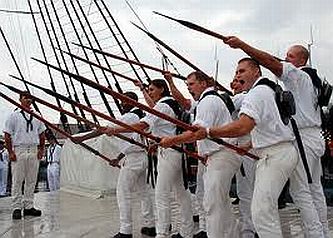
Above photo illustrates British sailors demonstrating how in proper drill practice how boarding pikes were used as defensive weapons against attacking boarders. It appears that the Model 1888 Boarding Pike is being used in this drill. Also note the boarding axes attached to the back of each sailor - no "jammed in the belt swashbuckling" for British Royal Navy sailors!
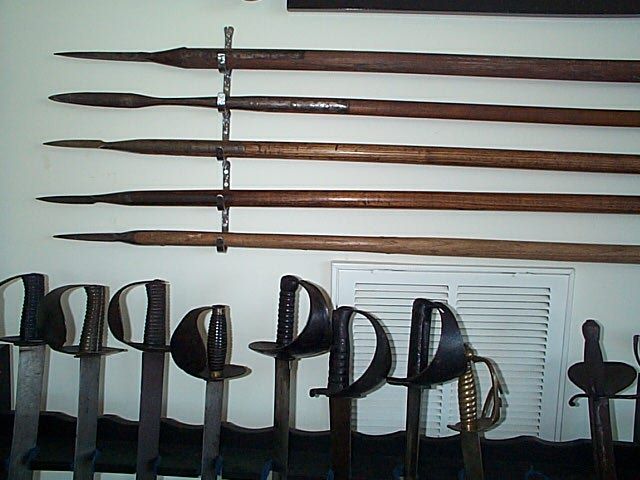
Photograph to the left is illustrating five 18th/19th Century Boarding Pikes.
The top two are American and the bottom three are British boarding pikes. Note how the American pike heads appear to be a bit longer and narrower while the British pike heads appear to be a bit shorter and squatter.
All 5 of models of these boarding pikes are documented in William Gilkerson's "Boarders Away" which is the industry standard in identifying naval cutlasses, boarding axes, and boarding pikes.
Prior to the advent of a rapid firing pistol or rifle the Boarding Pike was used to effectively repel boarders as they were climbing up the side of a wooden hull or swinging into the raised defensive protective netting.
The major differences between a standard infantry spear or cavalry lance is that the boarding pike's total length of about 7' to 8' was a bit shorter than its cousins which were typically 9' and longer.
The naval boarding pikes spike or blade itself was also thinner or slimmer than the spear or lance, and did not have any projections and was seamlessly smooth where it was fastened onto wooden shaft or haft. This was necessary so that the blade or spike could work its way through and not get caught up into any of the protective netting, associated rigging, any downed rope or canvas sail.
We here at The Pirates Lair utilize and refer to the fantastic work found in the reference guide "Boarders Away" by William Gilkerson. While we have added to our knowledge due to hands on experience with these boarding pikes and similar sea service weapons, we have never found Gilkerson to be wrong, ever.

Above photo shows three British Royal Navy Boarding Pikes: two well documented and stamped model 1888 boarding pikes (top and middle), and an unmarked early model 1800 on the very bottom. The 1888 model spikes are 3-sided triangular, while the model 1800 is a 4-sided spike. The langets on the 1888 models are substantially shorter than on the earlier 1800 model. Overall length of the model 1888 is 91" while the model 1800 is 92".
The wooden stave on the model 1800 is certainly ash, while to our untrained eye we are not certain of the wood used on the model 1888, though whatever wood was used it is the same on both.
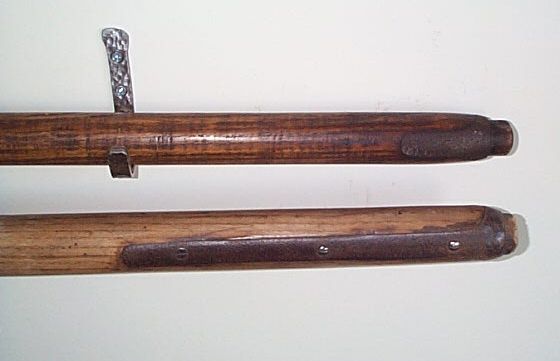
Photo above shows the butt of both 1888 and 1800 boarding pikes illustrating how the wooden staves or hafts of both wooden butts protrude through the iron shoes or heels: the model 1888 (on top) shows the now formalized short single riveted 2.5" steel shoe; while the 7.5" 3-riveted steel shoe of the model 1800 is longer and sawn off allowing the wood to protrude through. The steel butt shoe or heel on the 1800 model originally covered the entire wooden butt terminating in a pointed butt shoe. This pointed steel butt shoe would dig into the ships decking and was potentially harmful to fellow sailors standing behind the pikeman, so they were typically cut off either aboard ship or at the Ministry of Ordinance.
BELOW ARE PHOTOS AND DESCRIPTIONS OF THE LATE 19TH CENTURY MODEL 1888 BRITISH ROYAL NAVY BOARDING PIKE

Photo above shows the two Model 1888 British Royal Navy Boarding Pikes currently in the collection of The Pirates Lair: the top pike originally found here in the U.S. is only 51" long as its haft or stave has been cut in about half, probably when shipping from the UK to the US to cut down on cost. The bottom boarding pike was found in the UK and is the full regulation length of 91".
Upon close examination, the 3-sided spike heads are virtually the same however the slight differences are that the bottom has the number "49" die stamped into the top shoulder of one of the langets while the other has no number.
Additionally both Model 1888 boarding pikes are stamped on a single langet with arsenal marks: the capital letter "N" below that the "Broad Arrow" or crows foot above the initials "EFD" (most likely an inspectors initials), below that the Royal Cipher consisting of a "Crown" above the numeral "56" which is above the letter "E", further down the langet is the date "'99". Now it is a bit unclear as to whether the date is '89 or '99 because they are shallow die stamps on both models.
However while we want to believe it is '89, it could also certainly be '99 which is what we think it is.

Full 91" overall length of the Model 1888 Royal Navy Boarding Pike. Note the slight bend and warping that came with age. This warping is unfortunately not uncommon.

Closeup photo of the Model 1888 3-sided 5" Spike Head.

Closeup photo of the Model 1888 3-sided 14.75" Spike Head and 7.5" Langets and how they are attached to the stave or haft of the boarding pike with securing 3 screws/rivets.

Closeup photo of the Model 1888 2.25" steel heel or shoe butt.


Photo to the left shows the arsenal markings: "Broad Arrow" over initials "EFD" and lower down the Royal Cipher "Crown" over the number "56" above the letter "E", lower further is the date '89 or '99.
Photo to the right shows the capital letter "N" which represents Navy - this letter replaced the previously used abbreviations of "WD" for War Department and "BO" for Board of Ordinance.

Closeup photo of the Model 1888's number "49" die stamped onto the shoulder of one of the langets. We are assuming that this is a rack or inventory number. Only one of our Model 1888's has this stamped number.
BELOW ARE PHOTOS AND DESCRIPTIONS OF THE EARLY 19TH CENTURY MODEL 1800 BRITISH ROYAL NAVY BOARDING PIKE

The Model 1800 - an early 19th Century Boarding Pike. Note the 4 securing screw/rivets on the above long langet. The entire overall length of the spike head and langets is 24.25" long!

Closeup photo of the 5" 4-sided spike head and 18" long langets of the early 19th century Model 1800 British Royal Navy Boarding Pike.
This particular early 19th century boarding pike has been well documented and sports an ash stave or haft as well as a steel butt shoe. The steel butt shoes have been seen with and without pointed heels - it is assumed that the pointed heels were removed so they would not dig into the wooden decking or injure fellow sailors during practice drills and battle. This particular model has had its pointed heel removed allowing a portion of the wooden butt to protrude through.

Note how the ash wood stave tapers down where the steel show and langets are attached making the stave ovoid in shape.

Closeup photo of the steel butt shoe of the model 1800 British Boarding Pike. Note the long langets holding the shoe onto the wooden ash stave with part of the wood protruding through the heel.

Closeup of the wooden ash butt of the boarding pike protruding through the steel shoe where the point has been removed.

The ash haft or stave where the langets for securing both the spike head and steel shoe to haft have been planed and flattened from a round to an ovoid shape allowing for a better attachment of the langets.
Also note that while the spike and steel shoe on both the model 1800 and 1888 remained about the same length the langets securing them were shortened considerably on the 1888.
British Royal Navy Model 1888 Naval Boarding Pike For Sale and Available
Rare chance to own an authentic piece of Naval History! Classic late 19th Century British Royal Navy Boarding Pike 60" stave or haft. The stave is 3/4 length which was presumably cut because of damage to the butt. Langet has clearly and properly stamped arsenal marks, royal Victorian ciphers, and date of 1899. |

Click Photo! |
60" 3/4 Pike |
$995.00 |
To Order Call
540 659 6209 |
Below are links to other Antique Nautical and Naval Artifacts that may be of interest:
Click Here For Antique 19th Century British Royal Navy Mess Plates, Dinnerware, Rum Cups, Kegs and Mess Pails
Click HERE for WWII US Navy Anchor China
Authentic 100+ Year Old Nautical Antique Trunks
The Real Deal! Fully Restored Antique Trunks Like Sea Chests, Pirate Chests, Treasure Chests! |
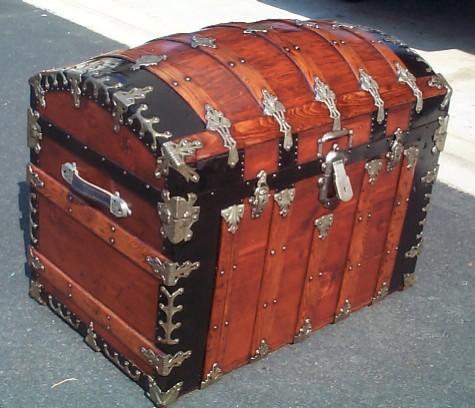
Click Here To Review Sample Engravings |
The Largest Selection of Antique Trunks on the Net to Choose From! |
OPTIONAL - Trunk Wood Engraving Examples and Prices
Custom Designed, Handcrafted, and Hand Lettered in Caligraphy on your Antique Chest |
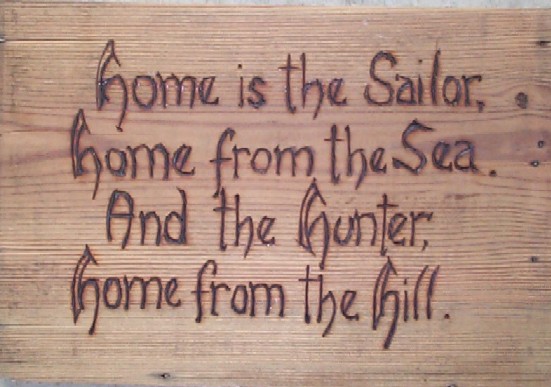
Click Here To Review Sample Engravings |
Personalize Your 100+ Year Old Antique Trunk in Perpetuity! |
Antique Trunks as a Shadow Box and Storage Chest!
Customer Photographic Examples of our Antique Trunks Being used as a Military or Naval Retirement Shadow Box and Storage Chest!! |
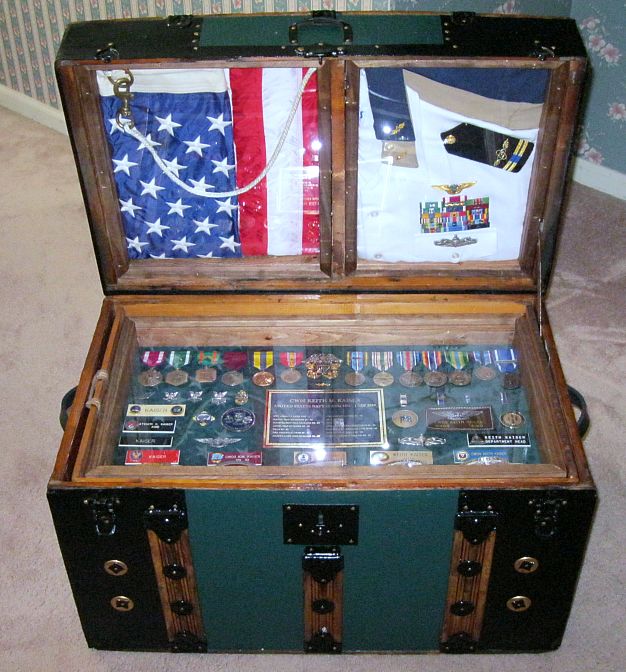
Click Here for Sample Shadow Box Photographs From Customers |
Why just get a shadow box or a newly made trunk with no history! One of our 100+ Year Old Nautical Antique Trunks can be used for both a Shadow Box and Storage Chest for your Uniforms, Photograph Albums, and Memorabilia! |
The Pirate's Lair
Division of DataCity, Inc.
78 Canterbury Drive
Stafford, Virginia 22554
Phone: 540-659-6209
Click Here and Return to The Pirate's Lair Home Page www.thepirateslair.com
"Service Disabled Veteran Owned Small Business"
Or
Email the-pirate@thepirateslair.com


 Or Click HERE to return to The Pirate's Lair Home Page and Gangplank!
Or Click HERE to return to The Pirate's Lair Home Page and Gangplank!
Copyright(c) 2008 All Rights Reserved - Unauthorized downloading, copying or use of any html code, text or images found on this or on any other pages within the www.pirateslair.com website will be prosecuted.
Music Credits: Donald Where's Your Trousers/Drunken Sailor medley by The Bards
ANY TEXT BELOW THIS LINE IS SOLEY FOR THE BENEFIT OF SEARCH BOTS, SPYDERS AND OTHER DENIZENS OF THE DEEP DARK SEA INTERNET
The naval boarding pike was an indispensable part of a ships armament inventory for the deckhand.
One often sees pirates and sailors holding a cutlass in one hand with a boarding pike in another as they were used in conjunction with each other when boarding a naval vessel during a battle. The boarding as was used to clear ones own deck of debris including ropes and rigging which may have been shot away and fallen as well as digging hot shot out of wooden hulls, bridges, railings, decks, sails, etc etc.
The naval boarding pike as an offensive weapon was used to help a boarder climb up the side of an enemies wooden hull, then used to chop away at their rigging making it difficult or impossible for them to properly maneuver, and then to used as a personal weapon in close quarter combat. The boarding pike was also used to throw at an enemy to keep distance. In fact it has been said that a well thrown boarding ax was even more lethal than an early 19th century gun (both were equally only one shot!)

























